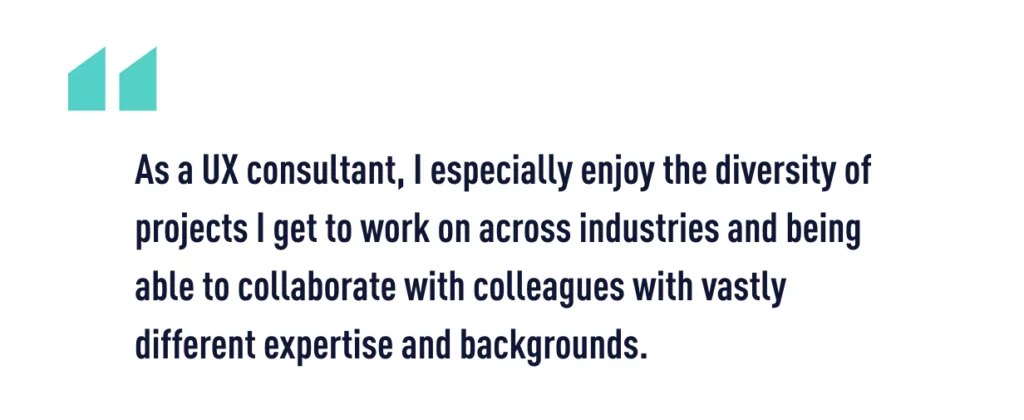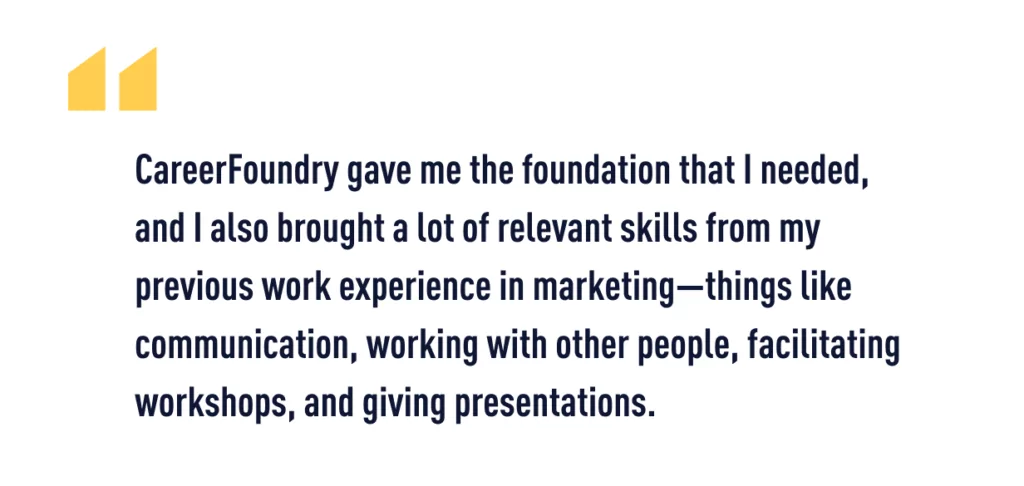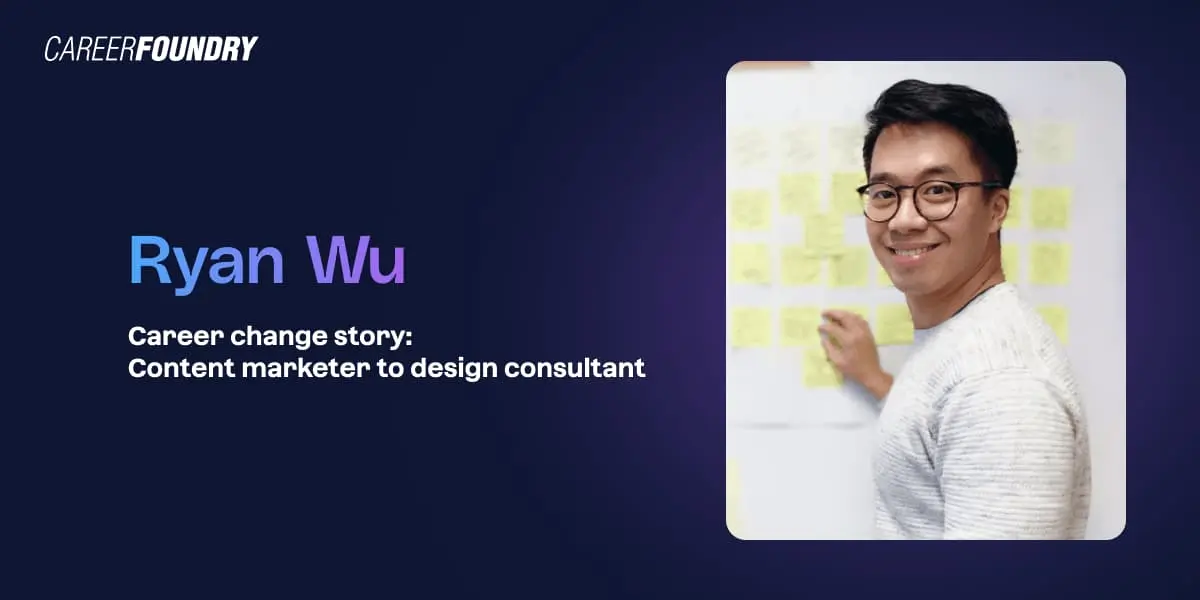When I first spoke to Ryan (and filmed this video with him), he’d just finished the UX Design Program at CareerFoundry and was working his first ever UX job. When I heard about his move into UX consulting—at McKinsey!—I couldn’t wait to catch up again.
Ryan is now Associate Design Director at McKinsey, though he had just started at McKinsey when we had our interview. We’re so impressed by his drive and ambition.
If you’re inspired by his story, try out our free 6-day UX design course.
Last time we spoke, you’d just started your first job as a UX designer. How did your job at McKinsey come about?
After the CareerFoundry program, I was working at Intive, a design agency in Berlin. Then, about 18 months in, I was headhunted by a McKinsey recruiter. I was actually in a process with KPMG at the time, who also headhunted me, but then I got the email from McKinsey and it all went super fast!
How did it feel to get that email?
I was freaking out! I was talking to McKinsey, a company I’d always wanted to work for. I really wanted to go into consulting, and here was this opportunity, but I still had my student portfolio—I hadn’t updated it since my first job in UX as I wasn’t expecting to leave Intive.
The call with the recruiter was amazing though, so I worked on updating my portfolio and CV overnight. The recruiter got back to me almost immediately and invited me to take part in a design challenge and technical interview the following week.
How did you prepare for the design challenge?
I got a book called Solving Product Design Challenges by Artiom Dashinsjy and read it twice, front to back. That really helped me because you never know what’s coming at you or what problem you’ll have to solve. The book really helped me get into the right mindset. I can really recommend it.
Editor’s note: Discover essential product design books in this article.
What was the interview process like?
The first step was a call with a design director, which lasted about an hour and had me solving a design challenge.
I remember that week being crazy; at that time I was doing a design thinking coach certification, then during my lunch break I had the design challenge for McKinsey, then I went back to the coaching workshop, then at 4pm I had the technical interview, which focused on my process as a designer. How do I work? What are the challenges I face? How do I solve problems and deal with conflict?
That sounds hectic! What happened next?
Basically, I passed both the challenge and the technical interview with great feedback, then I was invited to the office the following week. As I said, everything happened super fast! In the office, it was a four hour session divided up into four components: three meetings with the partners, and then a portfolio review.
The partner interviews focused on personal stories—they call them personal experience interviews (PEI), so the questions are very behavioral based. “Tell me about a time when…” type of questions: a time when you failed, showed empathy to team members, led your team—they want examples to see if you have the right mindset.
Then, for the portfolio review, I gave a forty minute presentation to show my design work and talk through my processes with a design director. Overall, including the call with the recruiter, I went through seven interview rounds!
Seven interview rounds! That’s intense. How did you feel? Were you well prepared?
There is some information about the interview process on the McKinsey website, so I was somewhat prepared. But, to be honest, in the interview they can go left and right, they can dig deeper into certain things, so you really never know!
I have to say, though, after the first talk with one of the partners, I felt so comfortable. And the second call was the same—overall, I had a really good feeling, but you never know, right?
What was it like to receive the final job offer?
My sister was visiting me in Berlin at the time, so after I finished the interviews, I went to meet her for a drink, then twenty minutes later, I got a call from one of the partners who basically said: “Ryan, you’re amazing, we’re going to hire you! The HR recruiter will call you tomorrow morning with an official offer.” I was like “Oh my gosh, what just happened?! I have a job at McKinsey now!”
It was probably the best recruiting experience I’ve ever had. Super efficient, supportive, and kind. I was amazed at the efficiency and kindness of all the people I had dealt with. It was a really great experience!
Amazing! So you started at McKinsey in November 2019. How was it starting your new role?
McKinsey is such a good firm. They’re super organized and they created an amazing onboarding experience for all the new consultants. I think the class of November 2019 was the biggest they’ve ever had for the German offices; I think there were over 100 of us starting!
We had five days of sessions on various topics, such as company values and mission, diversity, LGBTQ, and then a session to prepare you for your first project.
Now you’ve been there for a while and settled in, can you tell me more about what it’s like to work as a UX consultant?
The role is extremely versatile. I’ve already worked in over seven industries. I started working in e-mobility, then I did pharma, automotive, public sector, travel, e-commerce, and now I’m working in healthcare.
We spend about a month really trying to understand the needs of the user, doing customer research, leveraging external resources, talking to experts and different persona types. We try to find their pain points, come up with concepts, and draw wireframes—that’s all within the first month.
It’s incredible; I really get to cover the whole spectrum of UX and UI. And with practice, you get to be really good at all the different components, like user interviews.
After the research phase, we ideate together as a team and work really closely with the clients. We create UI concepts, and if it’s a new idea, we’ll visualize it with wireframes or prototypes to bring the concepts closer to our stakeholders!
After the ideation and design phase, we’ll help the client think about the long-term impact, so we might conduct research into the financial implications of a product or new set of features, for example, and the business opportunities that might present.
It sounds like the role is both strategic and very hands-on in terms of design. Is that right?
Very much so! Even as a UX design consultant I still create low-fidelity wireframes to get initial feedback and iterate on those. Then I create visuals to support the marketing team and to help the client and any investors understand the concept. Because pictures and visuals really help people to understand certain concepts, right?
If the client decides to go through all the phases, I get to see the project through from conception to launch. In some cases, we help to create design systems, to determine the direction for the user interface, and even work together with the developers to get the product built. So we can really go through the process from start to finish: user research, prototyping, testing, creating the UI, handing off to developers—everything!
What do you enjoy most about working as a UX consultant?

Working as a UX design consultant is very cross-functional, so we’re not purely helping the client to build, say, an app—we’re also working on the business strategy, looking at the bigger picture.
And I love that I touch on such a variety of different components. As I said, I’m not just thinking purely about design and user experience, but also about what that means for the business. That’s what’s really great about my work; I can collaborate with different people across different work streams and really align to make a positive impact.
When you were first considering a career change from marketing, did you always know that you wanted to move into UX consultancy?
I always thought about moving into consultancy, even when making a career change from marketing and before studying UX. The idea of being able to work in different sectors and solve different problems always intrigued me.
Because of my academic background, I thought it would be hard for me to get into consultancy, and I’d actually never tried, but then I encountered it more closely at a recruiting event and thought it could be a possible career path. I also never thought that design and consultancy could go together, but they do!
You’ve successfully made a career change from marketing into design. What’s been the steepest learning curve for you so far?
It’s not so much the “learning UX” part—once you’ve got those skills (from the UX program), you just have to build upon them. You eventually get better at the UI part, and at user research.
I think the real learning curve for me was getting into the groove of the job; learning how to communicate and align, dealing with difficult topics, solving disagreements, and getting everybody on the same page. That’s the most difficult part of the job! Some of my colleagues are so good at it because they’ve got experience, so I try to observe them and see how they deal with those difficult conversations, and how they align when clients have a different understanding or expectation. Bringing all those moving parts and people together seamlessly is an amazing skill, and it’s really difficult. I’m still practicing!
My whole experience has been a learning curve though, to be honest. At McKinsey, the hours are long, but as my dad keeps telling me, it’s like they’re paying me to go to school. I’m learning a lot while working there; it’s like a career accelerator! And I was promoted after one year. In general, I’ve learned to communicate better, and to help key stakeholders understand the overarching message. That’s really crucial as a UX consultant.
Where do you see yourself in five or 10 years from now?
It’s pretty open, but I definitely see myself here for the next four or five years at least. I can see myself growing into a design director role, carrying a lot of responsibility in terms of planning out projects and helping other designers to grow.
Editor’s note: he did it! Ryan’s now an associate design director at McKinsey.
Right now, I still have a lot to learn, so for the next couple of years, I’d just like to experience different industries. I really enjoy working in healthcare, and I also like e-commerce and the travel industry. I’m fairly open right now; maybe I’ll be doing hands-on design work, maybe I’ll be focusing more on strategy. Maybe I’ll have my own business! It’s hard to say, but the next five years will be with McKinsey.
Looking back on your journey, how do you reflect on your experience with the CareerFoundry UX Design Program?
The great thing about CareerFoundry is that it’s remote; that was the number one value proposition for me, as I couldn’t quit my job. Then, of course, there’s the mentorship and support. You’re able to talk to a real person with real work experience, and that’s so valuable.

In UX, a lot of learning is done on the job, but those transferable skills are all really important and you can bring those with you from other fields. So, it’s a combination of things that have set me up for success: soft skills from my previous jobs, design skills and mentorship from CareerFoundry, and continued on-the-job learning!
What advice would you give to anyone else considering a career change from marketing and considering CareerFoundry?
I would say, don’t be afraid. Just do it. I was also a bit afraid, but you always have to take that risk. If you’re really interested in a topic then go for it. If you can’t quit your job or don’t have the money to study full-time, do it on the side like I did. I was working and learning, and I had nothing to lose; either way, you come out with an additional skillset.
In my case, it turned out to be life-changing because I got a new job afterward. It changed my career, and then, a year and a half later, it changed my career again. Don’t be afraid to step out of your comfort zone and learn something new—whether it’s UX, project management, psychology, or whatever. If there’s something you want to do, don’t be afraid to try it out.
It’s also helpful to talk to people who have done it. Reach out to other people, and I’m sure they’ll be willing to give their two cents on their experience and tell you about the motivation that led to their own career change. Before I signed up for CareerFoundry, I wrote to about ten people on LinkedIn and asked for their thoughts on the program. That helped to reassure me that, yes, I should do this!
Excellent advice! Thanks Ryan, and congratulations once again on landing your dream job.
Are you dreaming of a career in UX? Do what Ryan did: book a call with a program advisor—they’ll help you figure out your next steps. You can also get a taster of UX design with this free, introductory short course.
Ryan is just one of hundreds of CareerFoundry alumni who are forging careers they love after taking the leap to learn new skills. Check out these other success stories from other CareerFoundry graduates who made a career change from marketing into UX:
- From Marketing To UX: Finding My Feet In UX strategy
- How I Went From Being An SEO Editor To Unlocking My True Potential In UX
Or, if you’re curious to learn more about what it’s like to be a consultant, check out this success story from Ray who swapped fashion operations for business intelligence consultancy.
